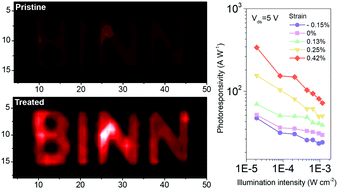Defect repair for enhanced piezo-phototronic MoS2 flexible phototransistors†
Abstract
The recent emergence of two-dimensional piezoelectric monolayers has provided a powerful platform for exploring the piezo-phototronic effect at the atomic scale, giving rise to multiple new physics and innovative device applications. However, being atomically thin, the piezoelectric properties of these materials are extremely vulnerable to structural defects, which may largely limit their practical use in high performance piezo-phototronics. In this study, we demonstrate the feasibility of piezo-phototronic effect enhancement in chemical vapor deposition grown MoS2 through sulfur vacancy repair and carrier concentration manipulation. Compared with flexible phototransistors fabricated with the as-grown MoS2 monolayer, a more prominent piezo-phototronic modulation impact was achieved after defect repair. This improvement originates from improved crystallization and a suppressed free-carrier screening effect in semiconducting MoS2. Under illumination of 19.1 μW cm−2 (532 nm wavelength), a 5.6-fold increase of responsivity is demonstrated when a 0.42% uniaxial tensile strain is applied and the optimized photoresponsivity reaches up to 339.2 A W−1. This structure–property relationship research could advance our fundamental understanding of the piezo-phototronic effect in 2D ultrathin materials and may serve as a general strategy for the performance enhancement of novel 2D optoelectronics.



 Please wait while we load your content...
Please wait while we load your content...